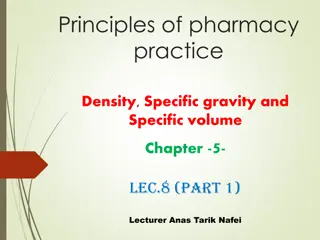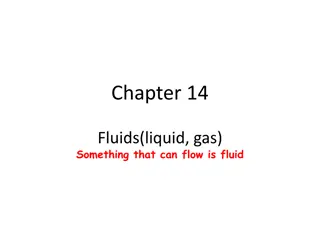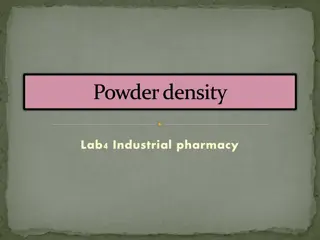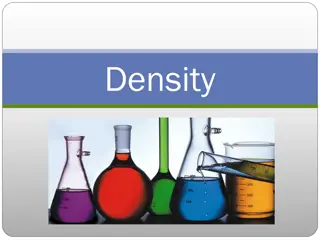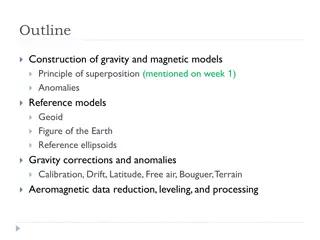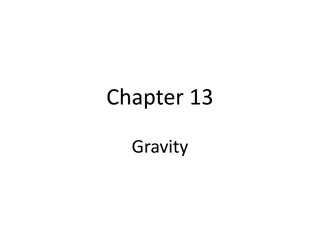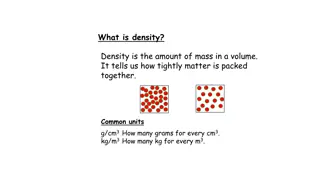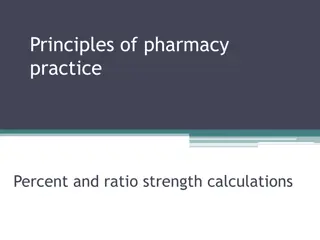Understanding Density, Specific Gravity, and Specific Volume in Pharmacy Practice
Explore the principles of density, specific gravity, and specific volume in pharmacy practice. Learn how to define and calculate these properties, apply specific gravity conversions, and understand the differences between density and specific gravity. Discover practical examples and calculations to enhance your understanding of these key concepts.
Download Presentation

Please find below an Image/Link to download the presentation.
The content on the website is provided AS IS for your information and personal use only. It may not be sold, licensed, or shared on other websites without obtaining consent from the author. Download presentation by click this link. If you encounter any issues during the download, it is possible that the publisher has removed the file from their server.
E N D
Presentation Transcript
AL- Mustaqbal University College Pharmacy College Principles of Pharmacy Practice Lectuer: 3 Prof. Dr. Jabar Faraj AL-Wakeel Assist. Lecturer. Mustafa Ewad
Density, Specific Gravity, and Specific Volume
Objectives: Define density, specific gravity, and specific volume and determine each through appropriate calculations. Apply specific gravity correctly in converting weight to volume and volume to weight.
Density (d) Density (d) is mass per unit volume of a substance. Density Unit: grams per cubic centimetre (g/cc) The density of water is 1 g/cc because the gram is defined as the mass of 1 cc of water at 4C. Because the United States Pharmacopeia states that 1 mL may be used as the equivalent of 1 cc, the density of water may be expressed as 1 g/mL
Specific gravity (sp gr) Specific gravity (sp gr) is a ratio, expressed decimally, of the weight of a substance to the weight of an equal volume of a substance chosen as a standard, both substances at the same temperature or the temperature of each being known. Water is used as the standard for the specific gravities of liquids and solids & the standard for gases is hydrogen. Specific gravity may be calculated by dividing the weight of a given substance by the weight of an equal volume of water, that is:
Example: If 10 mL of sulfuric acid weighs 18 g, and 10 mL of water, under similar conditions, weighs 10 g, the specific gravity of the acid is: Note: Substances with sp. gr. < 1 are lighter than water. Substances with sp. gr. > 1 are heavier than water
Density vs Specific Gravity Density Specific Gravity Density has a unit. Dimensionless (has no unit, it is a ratio) value is constant under controlled conditions Value changes depending on the unit Water density = 1g/ml = 1000g/L = 62.5 lb/ft3 Specific gravity of water always =1
Calculations of Specific Gravity 1. Using known weight and volume 2. Pycnometer or specific gravity bottle 3. Displacement or plummet method
1. known weight and volume Ex 1: If 54.96 mL of an oil weighs 52.78 g, what is the specific gravity of the oil?
EX 2 : If a pint of a certain liquid weighs 601 g, what is the specific gravity of the liquid? 1 pint = 16 fl. oz.= 473 mL Equal volume of water = 473 mL 1 pint of water weighs 473 g
2. Pycnometer or specific gravity bottle A pycnometer is a special glass bottle used to determine specific gravity. Pycnometers are generally available in volumes ranging from 1 mL to 50 mL. In using a pycnometer Determine the weight of the pycnometer empty, then filled with water, and then filled with liquid for which we need to determine the specific gravity. After that use the measurements in the equation of sp gr
3. Displacement or plummet method Based on Archimedes principle: A body immersed in a liquid displaces an amount of the liquid equal to its own volume and suffers an apparent loss in weight equal to the weight of the displaced liquid. Thus, we can weigh a plummet when suspended in water and when suspended in a liquid the specific gravity of which we want to determine; and by subtracting these weights from the weight of the plummet in air, we get the weights of equal volumes of the liquids needed in our calculation. Ex: A glass plummet weighs 12.64 g in air, 8.57 g when immersed in water, and 9.12 g when immersed in an oil. Calculate the specific gravity of the oil.
Use of specific gravity in calculation of weight and volume When specific gravity is used as a factor in a calculation, the result should contain no more significant figures than the number in the factor. Specific gravity is a factor that expresses how much heavier or lighter a substance is than water where water is the standard with a sp gr of 1.0. A liquid with a specific gravity of 1.25 is 1.25 times as heavy as water A liquid with a specific gravity of 0.85 is 0.85 times as heavy as water.
1. Calculating Weight, Knowing the Volume and Specific Gravity Ex: What is the weight, in grams, of 2 fl. oz. of a liquid having a specific gravity of 1.118?
2. Calculating volume, knowing the weight and Sp Gr Ex: What is the volume, in millilitres, of 492 g of nitric acid with a specific gravity of 1.40? Ex: What is the volume, in millilitres, of 1 lb of methyl salicylate with a specific gravity of 1.185?
Ex: What is the volume, in pints, of 50 lb of glycerin having a specific gravity of 1.25? Ex: What is the cost of 1000 mL of glycerin, specific gravity 1.25, bought at $54.25 per pound?
Special Considerations of Specific Gravity 1. 2. Conversion of the weight of an ingredient to volume and vies versa 3. Measure the weight when formula is expressed in unit of volume or weigh an equivalent amount when formula is expressed in units of volume 4. Calculate equivalent strength of a preparation on the basis of weight or volume 5. Automated Total Parenteral Nutrition (TPN) compounders Pharmaceutical Applications: Clinical applications: 2. Specific gravity is an important factor in urinalysis. Normal Sp Gr of urine is 1.010 1.025 Higher than normal sp gr: urine is concentrated possible due to excess electrolytes, glucose, protein or water loss. Lower than normal sp gr: urine is dilute possibly due to renal disease or diabetes insipidus
Specific Volume Specific volume, in pharmaceutical practice, is an abstract number representing the ratio, expressed decimally, of the volume of a substance to the volume of an equal weight of another substance taken as a standard, both having the same temperature. Whereas specific gravity is a comparison of weights of equal volumes, specific volume is a comparison of volumes of equal weights. Because of this relationship, specific gravity and specific volume are reciprocals that is, if they are multiplied together, the product is 1. Since water is the standard then, specific volume tells us how much greater (or smaller) in volume a mass is than the same weight of water.
Specific gravity: comparison of weights of equal volumes Specific volume: comparison of volumes of equal weights Specific volume = 1/specific gravity If the substance is heavier than water: sp gr >1 , specific volume < 1 If the substance is lighter than water: sp gr < 1, specific volume >1 Specific volume is calculated by dividing the volume of a given mass by the volume of an equal weight of water. If 25 g of glycerin measures 20 mL and 25 g of water measures 25 mL under the same conditions, the specific volume of the glycerin =
Ex: Calculate the specific volume of a syrup, 91.0 mL of which weighs 107.16 g.? The specific gravity of the syrup = 1/0.849 = 1.178 Ex: What is the specific volume of phosphoric acid having a specific gravity of 1.71? Ex: If a liquid has a specific volume of 1.396, what is its specific gravity? .


